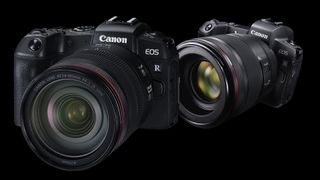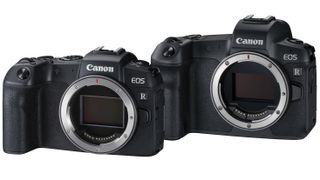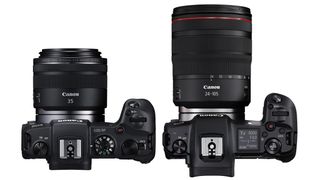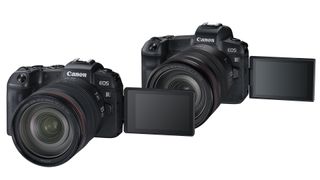Canon EOS R vs RP: the prices have got so close that it's now a serious question!
Our Canon EOS R vs RP comparison is all the more relevant now that the original EOS R is a real budget bargain

This Canon EOS R vs RP comparison has become a lot more relevant! Back when Canon introduced the EOS R (was it really as recent as 2018?) everything was simple. This was the only full-frame mirrorless EOS you could buy so you didn’t have to agonise over specs, features and prices.
When Canon introduced the EOS RP it also introduced a lot of questions. The EOS RP was a much cheaper entry point into Canon’s new EOS R system, and suddenly you had to figure out whether the more advanced specs and build of the EOS R were really worth the money. For a long time that was the status quo.
But then the EOS R5 and EOS R6 happened. Both were more advanced than the dear old EOS R, both had full-width 4K (the EOS R5, of course, has 8K too), and both had in-body stabilization. That left the original EOS R looking a bit sick and old. It's not, of course. It's a rather good camera with plenty of qualities and plenty of life left in it. But the camera market being what it is, the prices dropped, and dropped, and dropped... but you can still buy it. And at today's prices, the EOS R, even without in-body stabilization, looks rather good. It's also not a whole lot more expensive than the cheapskate (sorry, Canon) EOS RP.
So we’ve broken down all the key specifications and differences to examine them one by one to help you decide which is best for you; the deliberately cheap Canon EOS RP or the newly-cheap Canon EOS R.
• See also: Canon EOS R vs Sony A7 III | Canon EOS R10 vs EOS RP

1. Canon EOS R vs RP: Sensor
Why you can trust Digital Camera World
Both cameras have full-frame CMOS sensors, but the EOS R has slightly higher resolution at 30.3 million pixels versus 26.2 million pixels in the EOS RP. It’s a small difference that’s not terribly significant on its own. The EOS R brings other enhancements and features too, but if outright resolution is all you’re interested in, the EOS R’s advantage is fairly marginal.
• Winner: Canon EOS R thanks to its small resolution advantage
2. Processor and ISO range
It’s not just the sensor that affects a camera’s performance but its image processor too, and here the playing field is dead level. The EOS RP and the EOS R both have Canon’s DIGIC 8 image processor and, interestingly, they both have the company’s DLO (Digital Lens Optimizer) feature for enhancing fine detail in images shot with Canon lenses.
With the same processor and similar resolution, it’s perhaps no surprise that the EOS RP and the EOS R offer the standard ISO range of 100-40,000, expandable to ISO 50-102,400. We’re quite pleased that Canon has not reduced the maximum ISO of the EOS RP to keep it below the EOS R.
• Winner: No difference
3. Memory
Even the storage systems are identical. The EOS R has come in for some criticism for having just a single SD/SDHC/SDXC memory card slot, but it is UHS II compatible, so while it doesn’t take the new super-fast XQD/CFexpress cards been introduced by other brands, it should still be quite fast enough – and the EOS RP shares the same UHS II compatibility. Neither camera supports the latest CFexpress card format, so in that respect, both are starting to look a little dated.
• Winner: No difference

4. Image stabilization
Neither camera has in-body image stabilisation (unlike Canon's newer models) so both rely on lens-based image stabilization. The EOS RP does offer Digital IS for movies, which is not mentioned in the EOS R’s specifications, though the EOS R is better adapted to professional video use as we’ll see shortly.
• Winner: Canon EOS RP by a small margin, possibly, but neither has IBIS
5. Shutter speed range
Now the differences start to emerge. The EOS RP has a shutter speed range of 30-1,4000sec plus B, while the EOS R offers 30-1/8000sec plus B. That 1/8000sec shutter speed on the EOS R is not something you’ll use every day, but indicates a more advanced shutter mechanism and some conscious differentiation between this camera and the cheaper EOS RP.
• Winner: Canon EOS R with a slightly higher 1/8000sec maximum
6. Autofocus
The differences become more pronounced with the autofocus system. Both cameras offer Canon’s on-sensor Dual Pixel CMOS AF, as we’d expect, but while the EOS R offers 5,635 selectable autofocus points, the EOS RP’s total is slightly lower at 4,779 AF points. Both are huge numbers, of course, and in other respects these cameras look evenly-matched, both offering 88% horizontal and 100% vertical coverage.
But there are some important differences. The EOS R can focus in light levels down to -6EV, while the EOS RP is slightly behind at -5EV. The EOS RP hits back, though, with what Canon claimed at launch to be the world’s fastest AF speed of 0.05sec and, more importantly, the inclusion of Eye AF.
While the EOS RP sneaks ahead in a couple of areas, though, it has a major drawback for videographers – Dual Pixel CMOS AF is not available when shooting 4K video. For static videographers who prefer manual focus that might not be a problem, but for vloggers and journalists this could be a major drawback that forces them to drop the resolution to full HD, where Dual Pixel CMOS AF is available.
• Winner: Canon EOS R, especially for video
7. Video
That’s not the only difference between these two cameras’ video features. Both apply a heavy crop to 4K video footage, which does offer similar framing to the Super 35mm movie format but is unpopular with those who want full sensor width capture and no changes to the effective focal length of their lenses.
Regardless of that, the EOS R offers slightly faster 30p 4K UHD video against the 25p maximum of the EOS RP – and, of course, the Dual Pixel CMOS AF remains available, which is likely to be a far more important point to videographers.
While other specs are the same, including a 4K time-lapse mode and full HD at 60p/50p/30p/25p, with 4:2:0 8-bit internal recording, the EOS R can save 10-bit 4:2:2 video to an external recorder while the EOS RP only offers 8-bit. More importantly, the EOS R comes with Canon Log 1 mode (12 stops of dynamic range at ISO 400) but the EOS RP does not.
While these two cameras might look quite similar on paper, there are some quite severe restrictions on the EOS RP’s video capability compared to the EOS R.
• Winner: Canon EOS R, for AF and external output particularly
8. Continuous shooting
The EOS R is also a more powerful tool for sports and action photography. The EOS RP offers a pretty modest 5fps continuous shooting speed, and this drops to 4fps with AF Tracking enabled. The EOS R is much faster at 8fps, though speeds take a bigger hit if you use AF Tracking, dropping to 5fps.
The buffer capacities are similar. The EOS RP, with its lower resolution images, can keep shooting JPEGs until the memory card is full, or 50 raw files in a burst. The higher resolution EOS R is limited to 100 JPEGs (still plenty) and can capture 47 raw files or 78 images in Canon’s new and more efficient C-RAW format.
The EOS R also offers Canon’s DP RAW (Dual Pixel RAW) mode for maximising fine detail (though we’ve never noticed a big difference in side by side comparisons).
• Winner: Canon EOS R for its 8fps continuous shooting speed

9. Size and weight
This is where the differences between the EOS RP and the EOS R are most obvious. The EOS RP measures 132.5 x 85.0 x 70.0mm and weighs just 485g, body only, while the EOS R comes in at 135.8 x 98.3 x 84.4mm and 660g.
The EOS R has been designed more for handling than compactness, and it’s not just wider, taller and fatter than the EOS RP, it’s also 175g heavier. But small size and light weight aren’t everything. While the EOS RP is small, many of Canon’s RF lenses are not, and we’re willing to bet that the EOS R will feel a better-balanced camera with many of these new lenses.
• Winner: Canon EOS RP on paper, Canon EOS R (we suspect) in practice
10. Design and layout
Quite apart from the operational differences, there are big physical differences between the EOS RP and the EOS R. The EOS RP is a much smaller camera, but Canon has still found the space to include a regular mode dial – a feature missing on the EOS R. What the EOS R does have is Canon’s clever/controversial Multi-function Touch Bar, and a useful top-mounted status display for camera settings.
• Winner: Close, and down to personal preference

11. Viewfinder and rear screen
You’d expect Canon to look for places to save money on the EOS RP, and the viewfinder is one place where this has happened. Its 0.39-inch OLED EVF has a reasonable resolution of 2.36 million dots and offers 100% coverage with 0.7x magnification. The EOS R, however, has a larger 0.5-inch OLED EVF with 3.69 million dots, the same 100% coverage and a larger 0.76x magnification.
The EOS R also has a better rear screen. Both cameras have vari-angle touchscreens, but where the EOS RP makes do with a 3.0-inch 1.04 million dot display, the EOS R has a larger 3.15-inch screen with 2.1 million dot resolution. Quite often it’s not one single feature that helps you choose one camera over another, but a steady accumulation of small advantages like this one.
• Winner: Canon EOS R, size and resolution again
12. Battery life and connectivity
Battery life is another area where the more expensive EOS R wins. Its LP-E6 battery has the capacity for 370 shots, which is only average compared to rival full-frame mirrorless cameras, but well ahead of the meagre 250 shots you get from the LP-E17 battery in the EOS RP.
There’s a bit of a sting in the tail with the connectivity features too. Both cameras have Wi-Fi, microphone and headphone sockets, HDMI output and USB ports – but where the EOS R supports USB 3.1, the EOS RP makes do with old-tech USB 2.0. That might not be a problem if you use a card reader, but could be real drag if you use USB for image/video transfer.
• Winner: Canon EOS R, with better battery life and USB 3.1

Canon EOS R vs RP: Prices and verdict
The EOS R is still more expensive than the EOS RP, but its prices have been discounted more heavily and the gap is smaller than it was. The EOS R remains the better camera in a significant number of areas, though the EOS RP does run it pretty close for everyday amateur use, being both smaller and lighter and still significantly cheaper.
There’s a lot to weigh up when choosing between the EOS RP and the EOS R. Is the EOS R worth all that extra money? Do you lose too many key features when you ‘downgrade’ to the much cheaper EOS RP?
If you just want to dip your toe into the full-frame mirrorless camera market and you’re a stills photographer rather than a video specialist, the EOS RP is almost as good at a massively reduced price.
But if you’re a pro photographer and/or videographer, we think the extra performance and features of the EOS R will soon make you forget how much extra you paid for it. You can save some money with the EOS RP, but you might regret your cheapskating in the future.
You can see the latest Canon EOS R vs EOS RP price comparisons below.
How we test cameras
We test mirrorless and DSLR cameras both in real-world shooting scenarios and in carefully controlled lab conditions. Our lab tests measure resolution, dynamic range and signal to noise ratio. Resolution is measured using ISO resolution charts, dynamic range is measured using DxO Analyzer test equipment and DxO Analyzer is also used for noise analysis across the camera's ISO range. We use these real-world testing and lab results to inform our comments in buying guides. For compact cameras and phones, we judge on real world handling and photographic results alone.
Read more:
• Canon EOS RP won't kill M series, Canon confirms
• DSLR vs mirrorless cameras: How do they compare?
• Canon EOS R5: Everything we know so far
• Canon EOS R6: Latest news and rumors
Get the Digital Camera World Newsletter
The best camera deals, reviews, product advice, and unmissable photography news, direct to your inbox!

Rod is an independent photography journalist and editor, and a long-standing Digital Camera World contributor, having previously worked as DCW's Group Reviews editor. Before that he has been technique editor on N-Photo, Head of Testing for the photography division and Camera Channel editor on TechRadar, as well as contributing to many other publications. He has been writing about photography technique, photo editing and digital cameras since they first appeared, and before that began his career writing about film photography. He has used and reviewed practically every interchangeable lens camera launched in the past 20 years, from entry-level DSLRs to medium format cameras, together with lenses, tripods, gimbals, light meters, camera bags and more. Rod has his own camera gear blog at fotovolo.com but also writes about photo-editing applications and techniques at lifeafterphotoshop.com